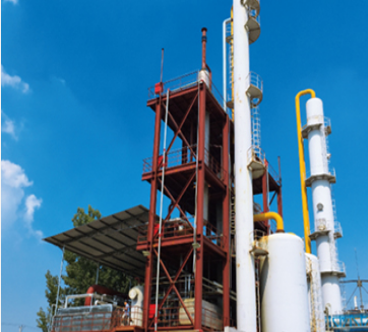生物脫硫過程分為兩種,一種是整合的,另一種是分離的。綜合生物脫硫是將一定量的空氣引入含硫化氫的沼氣中,混合后的氣體通過生物濾池去除硫化氫。這樣,在反應器內部安裝了塑料填料,營養液的循環將填料保持在濕狀態,并補充了脫硫所需的營養。集成的脫硫效率高,高達95%到99%,運行成本低,自動化程度高,易于操作且成本低。但是,一體化脫硫方法的填料容易堵塞,不僅影響處理效果,增加勞動強度,而且空氣直接與沼氣混合。一旦控制儀器發生故障,沼氣就很容易達到爆炸限度,安全隱患很高。另外,操作控制精度過高(溫度30-31℃),系統容易失控。如果生物脫硫產物是硫酸,則會形成大量的低濃度硫酸,難以處理。同樣,不可能處理高于15,000 ppm硫化氫濃度的沼氣。
There are two kinds of biological desulfurization process, one is integrated, the other is separated. Comprehensive biological desulfurization is to introduce a certain amount of air into the biogas containing hydrogen sulfide, and the mixed gas is removed by biological filter. In this way, plastic packing is installed in the reactor, and the circulation of nutrient solution keeps the packing in a wet state and replenishes the nutrition needed for desulfurization. Integrated desulfurization efficiency is high, up to 95% to 99%, low operation cost, high degree of automation, easy operation and low cost. However, the filler of the integrated desulfurization method is easy to be blocked, which not only affects the treatment effect and increases the labor intensity, but also directly mixes the air with biogas. Once the control instrument fails, the biogas will easily reach the explosion limit, and the potential safety hazard is very high. In addition, the operation control accuracy is too high (temperature 30-31 ℃), the system is easy to lose control. If the biodesulfurization product is sulfuric acid, a large amount of low concentration sulfuric acid will be formed, which is difficult to treat. Similarly, it is not possible to treat biogas with concentrations of hydrogen sulfide above 15000 ppm.

單獨的生物脫硫工藝采用單獨的生物脫硫方法。含硫化氫的沼氣首入生物洗滌器,在此與混合液體中的堿反應,從沼氣中去除硫化氫。來自生物洗滌塔的吸收液流到塔的底部并進入生物反應器。反應器底部有一個空氣分配系統,該系統向微生物提供氧氣,將反應器中的硫化物轉化為元素硫,同時再生堿性液體,并在分離器中分離出元素硫 。單獨的生物脫硫方案具有高脫硫效率(高達99%),年運行成本低,自動化程度高,易于操作以及無需與空氣直接混合即可安全操作沼氣的特點。它可以處理高濃度硫化氫的沼氣。但是運行成本比集成生物脫硫略高。
Separate biological desulfurization process adopts separate biological desulfurization method. The biogas containing hydrogen sulfide first enters the biological scrubber, where it reacts with alkali in the mixed liquid to remove hydrogen sulfide from the biogas. The absorption liquid from the biological scrubbing tower flows to the bottom of the tower and enters the bioreactor. There is an air distribution system at the bottom of the reactor, which provides oxygen to microorganisms, converts sulfide in the reactor into elemental sulfur, regenerates alkaline liquid and separates elemental sulfur from separator. The single biological desulfurization scheme has the characteristics of high desulfurization efficiency (up to 99%), low annual operation cost, high degree of automation, easy operation and safe operation of biogas without direct mixing with air. It can deal with methane with high concentration of hydrogen sulfide. However, the operation cost is slightly higher than that of integrated biological desulfurization.
兩種生物脫硫工藝均廣泛用于沼氣,垃圾填埋氣,天然氣,水煤氣和其他工業用氣生物脫硫工藝。集成的生物脫硫工藝具有較低的運營成本,并廣泛用于低濃度硫化氫(低于10,000 ppm)沼氣的發電和燃燒項目。單獨的生物脫硫過程具有很強的抗硫化氫負荷能力,并且空氣不會進入沼氣。廣泛用于高濃度硫化氫生物脫硫凈化過程中。
Both of them are widely used in biogas, landfill gas, natural gas, water gas and other industrial gas. The integrated biological desulfurization process has low operating costs and is widely used in power generation and combustion projects with low concentration of hydrogen sulfide (less than 10000 ppm). The single biological desulfurization process has a strong ability to resist hydrogen sulfide load, and the air will not enter the biogas. It is widely used in biological desulfurization and purification process of high concentration hydrogen sulfide.
The above is a detailed introduction of the new process principle of biological desulfurization. I believe you have already understood it. If you want to know more information, please click http://m.chinaktws.com Official website.
